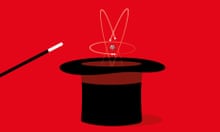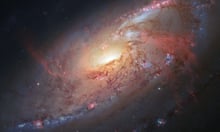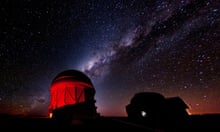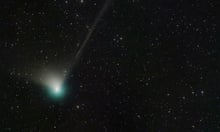Dark energy is the enigma at the heart of modern physics: the universe is supposed to be awash with the stuff, but it has never been seen and its nature is unknown.
When faced with a mystery of such epic proportions, simply eliminating certain options is considered a success. This week such an advance, using an ingeniously simple desktop experiment, was recognised by the prestigious Blavatnik award for young scientists.
Prof Clare Burrage, of the University of Nottingham and recipient of the £100,000 prize, said: “We don’t know what dark energy is. It’s the name we give to something we don’t understand so we can start talking about it. And when so little is known, even ruling things out feels like big progress.”
Dark energy was dreamed up to fill an enormous void in theoretical physics. Scientists had predicted that, due to the inward tug of gravity, the expansion of the universe ought to be slowing down. But observations of distant stars showed that, instead, the expansion of the universe is accelerating.
Dark energy is a placeholder for whatever is propelling this expansion and, to balance the necessary equations, it needs to account for 70% of the contents of the universe.
A popular theory is that dark energy is a “chameleon force”, which adjusts its properties according to the local environment. “In dense environments, your force becomes very short-range, but in empty space it becomes very long-range,” said Burrage.
This could explain how the elusive force could be powerful enough to govern the fate of the entire universe, but remain imperceptible in our own solar system.
Typically dark energy experiments involve space observatories, enormous particle accelerators or detectors buried deep underground. However, Burrage’s theoretical work proved that small and light objects in nearly vacuum environment on Earth may still feel the full force of dark energy. With colleagues at Nottingham and Imperial College London, Burrage devised a “chameleon trap” that could be built in a laboratory.
The setup involved dropping ultra-cold atoms into a bowling-ball sized vacuum chamber containing a lump of aluminium. If a chameleon force existed, it should have a higher value in the empty space and be “hidden” close to the heavy lump of metal.
By precisely tracking the motion of the atoms using pulsed laser light, the team were looking for any unexpected accelerations that could be due to a chameleon force.
“You’re looking to see if there’s an extra force pulling the atoms sideways,” said Burrage. “Obviously it would’ve been wonderful to see something.”
Unfortunately, no mysterious forces were uncovered, but the experiment was able to squeeze down the possible values that a chameleon force could take into a small window.
“With one upgrade of the experiment we hope to close that window,” Burrage said. “It’s definitely technologically achievable.”
The findings have had a positive reception, Burrage said, despite some theorists having spent years devising hypothetical chameleon forces.
“When you’re a theorist, you put stuff out into the world and a lot of the time people just say ‘Oh, that’s nice’ and move on,” she said. “So people were just excited to see tests being done.”
Some may be deterred by the narrow odds of a breakthrough in a field where so little is known, but for Burrage this is the attraction of working on dark energy.
“I’m very stubborn – it’s a family trait,” she said. “I’m a rock climber in my spare time. I like a challenge and I don’t give up easily.”
Her current work is focused on using data from the European Space Agency’s (Esa) Gaia mission, which is making detailed measurements of stars in the Milky Way.
Esa’s Euclid mission, which is squarely focused on the dark energy question, is expected to launch this year. The mission will look at how the universe evolved over the past 10bn years to look for imprints of dark energy.
“Euclid is the big one,” said Burrage. “It’s going to map the distribution of galaxies that we can see on the sky.”
The mission will observe up to 2bn galaxies using infrared and visible light to study their shape and motion. The aim is to get a more precise picture of the competing forces of gravity, which cause galaxies to clump together, and dark energy, which is driving the accelerated expansion of space.
“The fact that so little is known is exciting,” said Burrage. “It feels like somewhere you can make big progress.”










